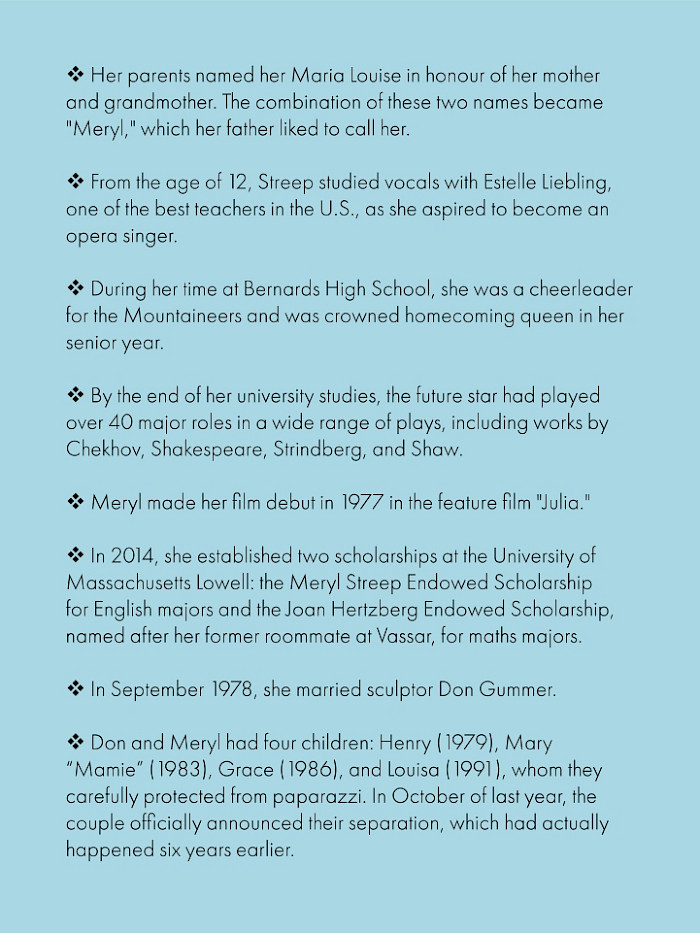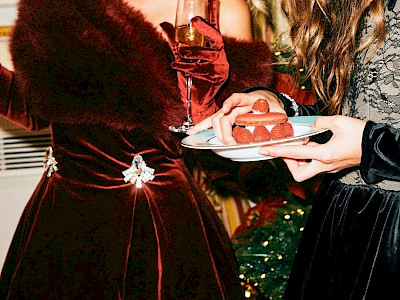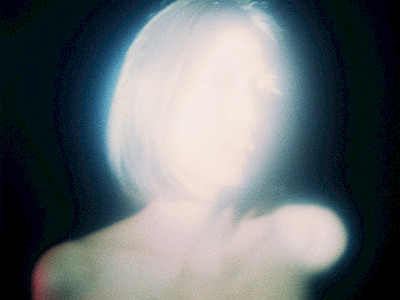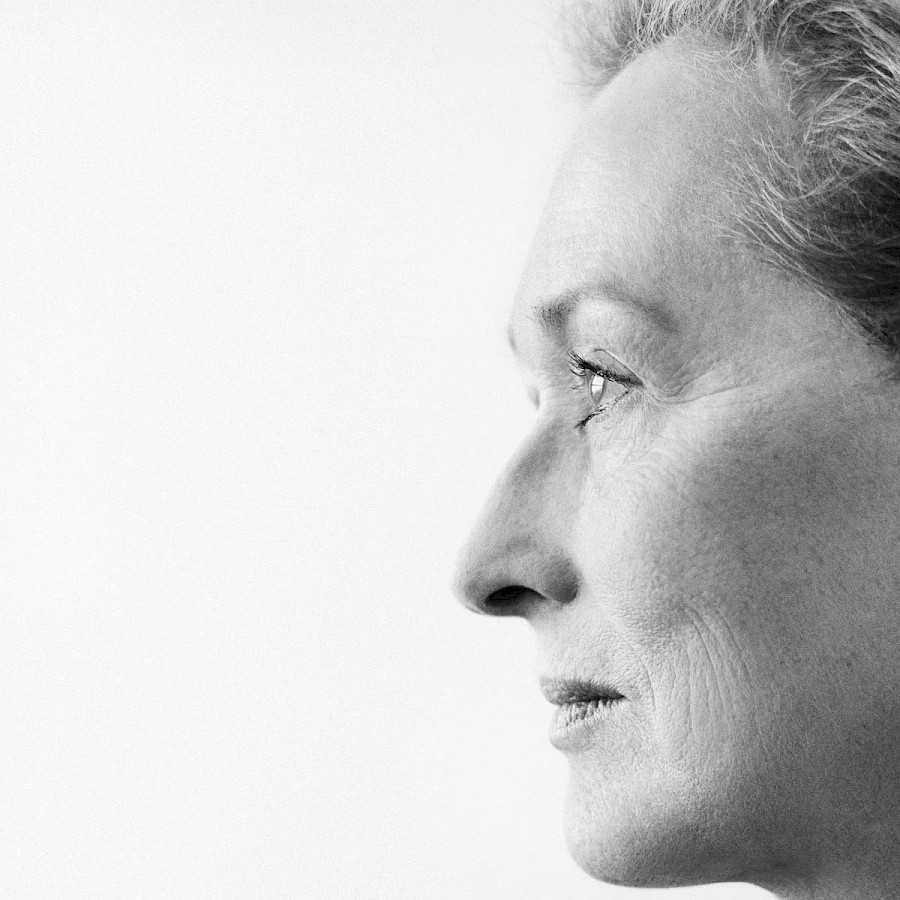
It has been thirty-five years since American actress Meryl Streep attended the Cannes Film Festival. This year, she had a special reason to visit the French Riviera – Côte d'Azur: she was awarded the Palme d'Or for her illustrious career. Over the past 50 years, Meryl Streep has received numerous honors. At the Oscars alone, she has been nominated 21 times and has won the prestigious statuette three times. Throughout the history of the American Film Institute, only Katharine Hepburn has surpassed Streep, with four Oscars to her name. Since Hepburn is no longer alive, Streep has the opportunity to break her compatriot's record. Meanwhile, in other awards, Streep has no equal: she has 33 nominations for the Golden Globe, winning 8 of them and also receiving the honorary Cecil B. DeMille Award. She has also received numerous prizes at international film festivals.
Meryl, at this year's Cannes Film Festival, you were awarded the Palme d'Or. What does this recognition mean to you?
Standing alongside those who have previously been honoured with this award makes me proud, humbled, and extremely excited. During the opening of the festival, I experienced a variety of emotions: joy and sadness, nostalgia and gratitude. It was hard to hold back tears when, during the opening ceremony of the festival, I watched a clip made from my films and saw myself on the big screen in my 20s, 30s, 40s, and 50s, and so on, up to where I am now. I was even more moved by the tears in the eyes of the audience. The prizes are a great honour, and I am grateful that my work is so highly appreciated. However, it is even more important for me to do what I love and to please the audience.
How do you manage to remain such a versatile actress?
I've always tried to challenge myself, which means not staying in one role. Playing Margaret Thatcher in “The Iron Lady” and the witch in “Into the Woods” are very different experiences that help me grow as an actress. Having been on screen for almost half a century, I have to work hard not to bore myself or others.
Your big-screen breakthrough came in 1978 with the film “The Deer Hunter,” where you starred alongside Robert De Niro...
It was a wonderful moment in my life. I wrote my own lines for my role, wanting to give the character more depth. In those days, it was not easy for actresses to speak out, let alone insist on changes to the script. Yet, it was important for me to show my acting independence. I have always believed that women's stories, with all their authenticity and complexity, deserve no less attention than the stories of men's exploits. Today, women are the focus of cinema, with many films dedicated to them. It was different at the beginning of my career. Back then, everything revolved around male superstars, with women playing only minor roles. Films were made by men, and that meant that cinema reflected their desires, aspirations, and perspectives. The first time I felt I was on an equal footing with men was when I played Miranda Priestly in “The Devil Wears Prada.” Cinema, for me, is magic above all else. I'm grateful to have lived my life in the enchanting world of film, contributing to its creation.
Many viewers remember you from the legendary film “Out of Africa,” which won 11 Oscars, including Best Actress. What are your favourite moments from the film?
It was a beautiful epic, and Sydney Pollack is exactly the kind of director I always agree to work with – a skilled craftsman who knows exactly what he wants and where he's going, which is what made our project a success. I remember when we travelled to Africa, we were warned about possible encounters with dangerous wild animals like hippos. Lions also roam Africa, but local laws prohibit using them for filming, so our lions were brought from California. During the lion scene shoot, I was assured the lion would be tethered. However, in the final take, he was unexpectedly freed and came too close to me, shocking me tremendously – a reaction the director wanted to capture.
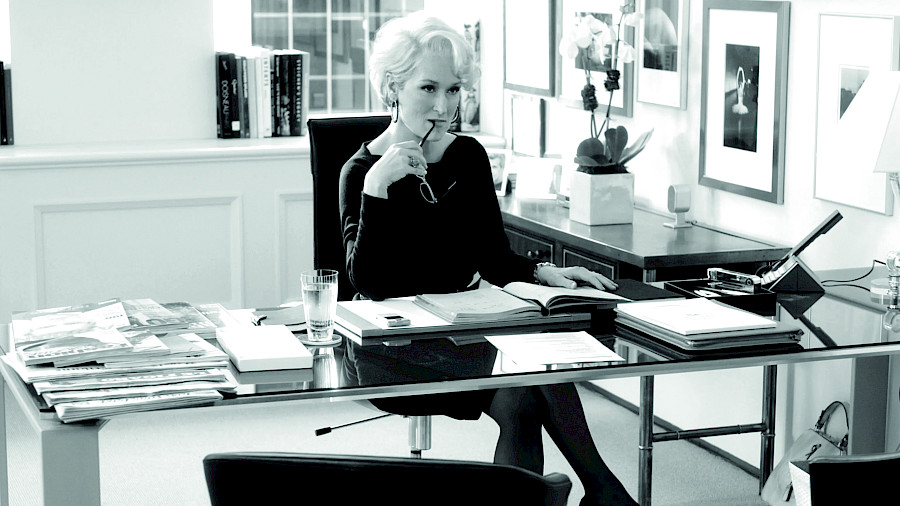 "The Devil wears Prada", 2006
"The Devil wears Prada", 2006
You've tackled some very dark roles, like your character in "A Cry in the Dark." How did you prepare for such a complex character?
Playing a mother accused of infanticide required delving deep into the character's psyche and understanding the nuances of her situation. Typically, in such roles, I aim to explore my heroines' most vulnerable moments, when they are most defenceless. These moments justify their subsequent actions and help me grasp their motivations and the complex facets of human nature, which defy simple categorisations of good and bad. This role earned me the Best Actress award at the Cannes Film Festival in 1989, but it also left me emotionally drained for a long time after filming. Subsequently, I opted for comedies, despite their daunting titles like “Postcards from the Edge”
and “Death Becomes Her.” This shift was intentional. Comedy, just like drama, presents its own challenges, but the comedies allowed me to challenge stereotypes about women and showcase that they can be as humorous, eccentric, and multifaceted as any man.
What attracted you to characters like Miranda in “The Devil Wears Prada” and Donna in “Mamma Mia!”?
Playing a dominant fashion magazine editor was incredibly enjoyable. However, I don't think everyone understood Miranda Priestly's character. Many perceived her as harsh. It's a paradox, but people often tend to dislike assertive women. Few consider her true position, the immense responsibility she carries, and the substantial financial decisions she must make. One wrong move could jeopardise everything. It's not just about her job and status; her mistakes could affect the livelihoods of many others. It's easy to label such a woman as cold and heartless, but understanding the intricacies of her role and the challenges she faces is much harder. As for Donna in “Mamma Mia!” I was stunned when offered the role, given my previous work. I saw it as fate, as I had always harboured a desire to be a singer despite never pursuing it professionally. This role gave me the opportunity to perform “The Winner Takes It All” in front of an audience, fulfilling a long-held dream. I couldn't believe I was getting paid to have so much fun. Each role offers a unique way to tell a story and connect with audiences. When I select a role, my motivation stems from a desire to delve into the diverse facets of the human experience.
In your interviews, you have often mentioned that when you were younger, you were concerned about your appearance...
When I was in school, I often felt insecure and unattractive. This feeling persisted into adulthood, notably during an encounter with producer Dino De Laurentiis. His son wanted me to star in his father's film, “King Kong.” During a meeting in his Manhattan office, De Laurentiis looked at me and remarked in Italian, “How ugly!” He assumed I wouldn't understand. In response, I replied in the same language that I regretted disappointing him, especially for a role in a film about a giant ape. That moment marked a turning point for me – I realised I could and would always stand up for myself. In my youth, I was very self- conscious about my nose, but later I decided never to undergo surgery, preferring to let directors find the best angles for me in their films.
Despite anxieties about your appearance, what made you decide to pursue acting?
High school theatre significantly boosted my self- confidence. When I started at the Yale School of Drama, I considered switching to law. Fortunately, I missed the application deadline for law school, so I stayed in acting school. It turned out to be for the best, as I soon had the opportunity to work with actors like Robert De Niro and John Cazale.
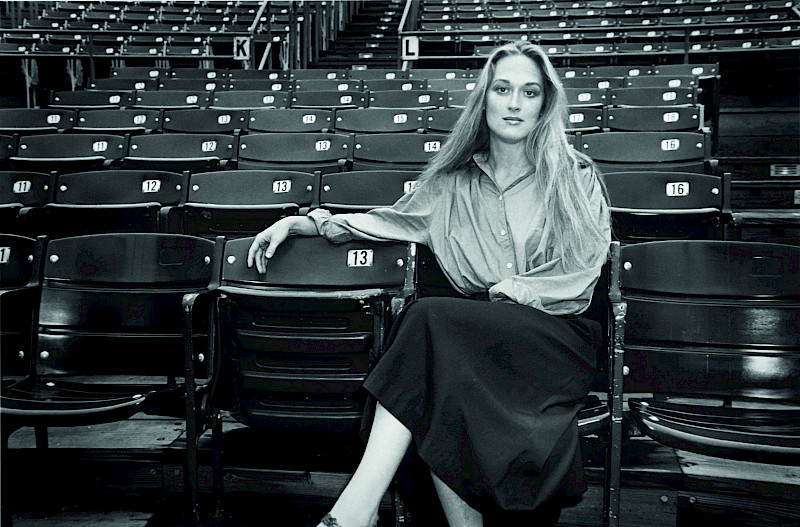
You once admitted that fear is the biggest motivation for people. What are you afraid of?
Fear helps develop the instinct for self-preservation. However, an actor always thinks about the moment when their career will be over. Those moments can come when you are young and have terrible scripts piling up on your desk. You read these scripts and think, “Do I really have to play this because nothing else will be offered?” It's often believed that an actress of my generation faces the most challenges when she reaches her forties. After forty, women of my generation were often destined to play roles as grotesque old women. When I turned forty, I too was overcome with longing. I remember that at that time I was offered three projects in which I had to play
a witch. I thought, “This is it! It's over!” But no, it's still going on.
Each role offers a unique way to tell a story and connect with audiences
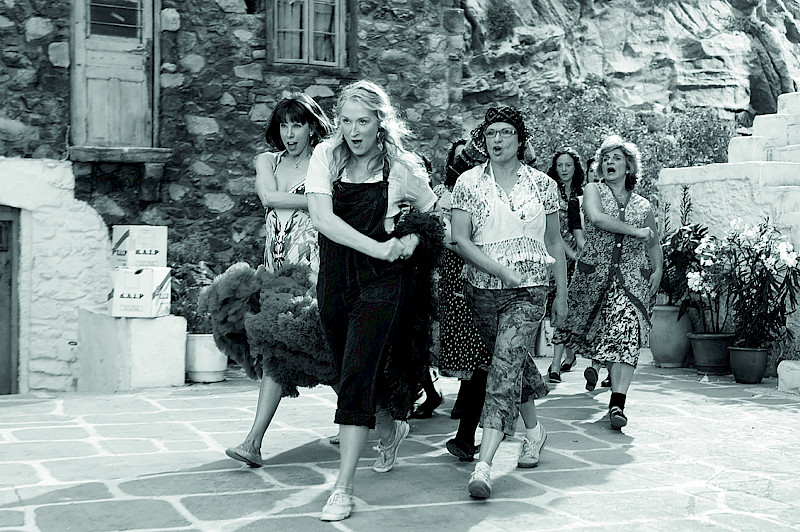 "Mamma Mia!", 2008
"Mamma Mia!", 2008
